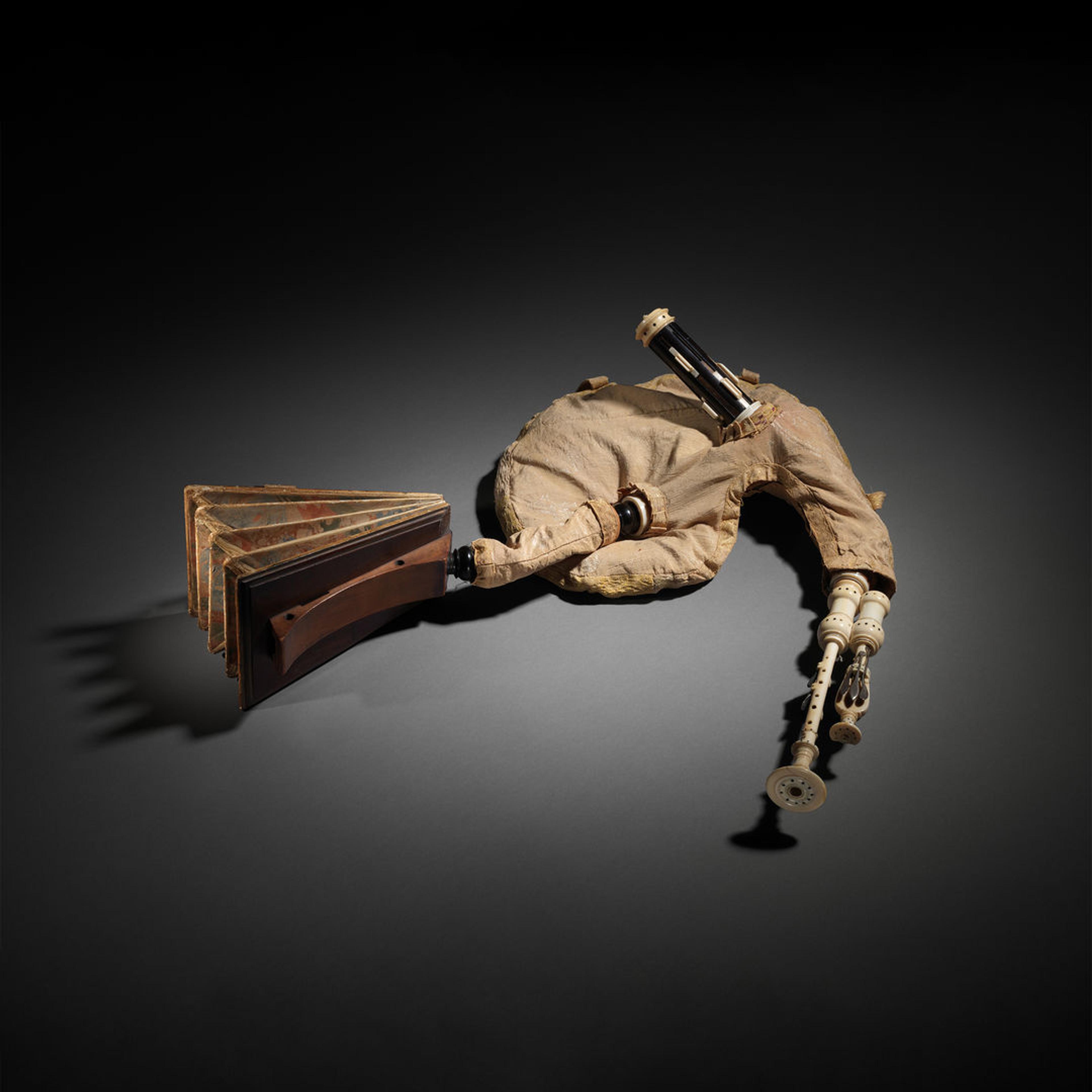Did you know that there are more than 130 different types of bagpipes around the world? From India to Ireland, Sweden to Libya, bagpiping covers a wide geographic expanse roughly aligned with the Indo-European map, as well as the Middle East and Northern Africa. In the instrument’s simplest form, bagpipes are composed of a bag and some pipes: the melodic pipe on which the tune is played, the drone(s) that create one or more continuous note(s), and the blow pipe, which brings air into the bag. The bag functions like an external pair of lungs and enables the instrument to maintain its characteristic sustained sound.
Bagpipes are thought to have emerged from the Middle East. The earliest named piper was Emperor Nero (37–68 CE), and the Greek historian and orator Dio Chrysostom (ca. 40–115 CE) has described the instrument in detail, throwing serious doubts as to whether Nero was piping or fiddling as Rome burned. Bagpipes became prevalent in Europe from the Middle Ages onward, rapidly spreading across the territory and taking on a variety of forms. Today, more than a hundred types of bagpipes are still played around the world.
Today, more than a hundred different types of bagpipes are still played around the world.
I discovered the bagpipes as a young teenager when visiting my Spanish pen pal in Galicia one summer. Northern Iberia has a rich culture of bagpipes, with about a dozen different types of instruments. I had unknowingly stumbled across one of Spain’s most vivid bagpipe cultures, kickstarting a lifelong passion. Over the years, I learned to play the Galician and French pipes as well as a few others, and have used my academic research as an opportunity to take a closer look at this diverse field.
The Metropolitan Museum of Art holds a rich collection of fifty-three bagpipes from across the world. Mainly collected by Mary Elizabeth Brown at the turn of the twentieth century, the instruments come from India, Egypt, France, Russia, the British Isles, Greece, Croatia, Spain, and many other locations. Alongside this rich collection, which speaks to the global diversity of the instrument, there are also many different examples of bagpipes scattered across the Museum in paintings, manuscripts, wall hangings, and sculptures.
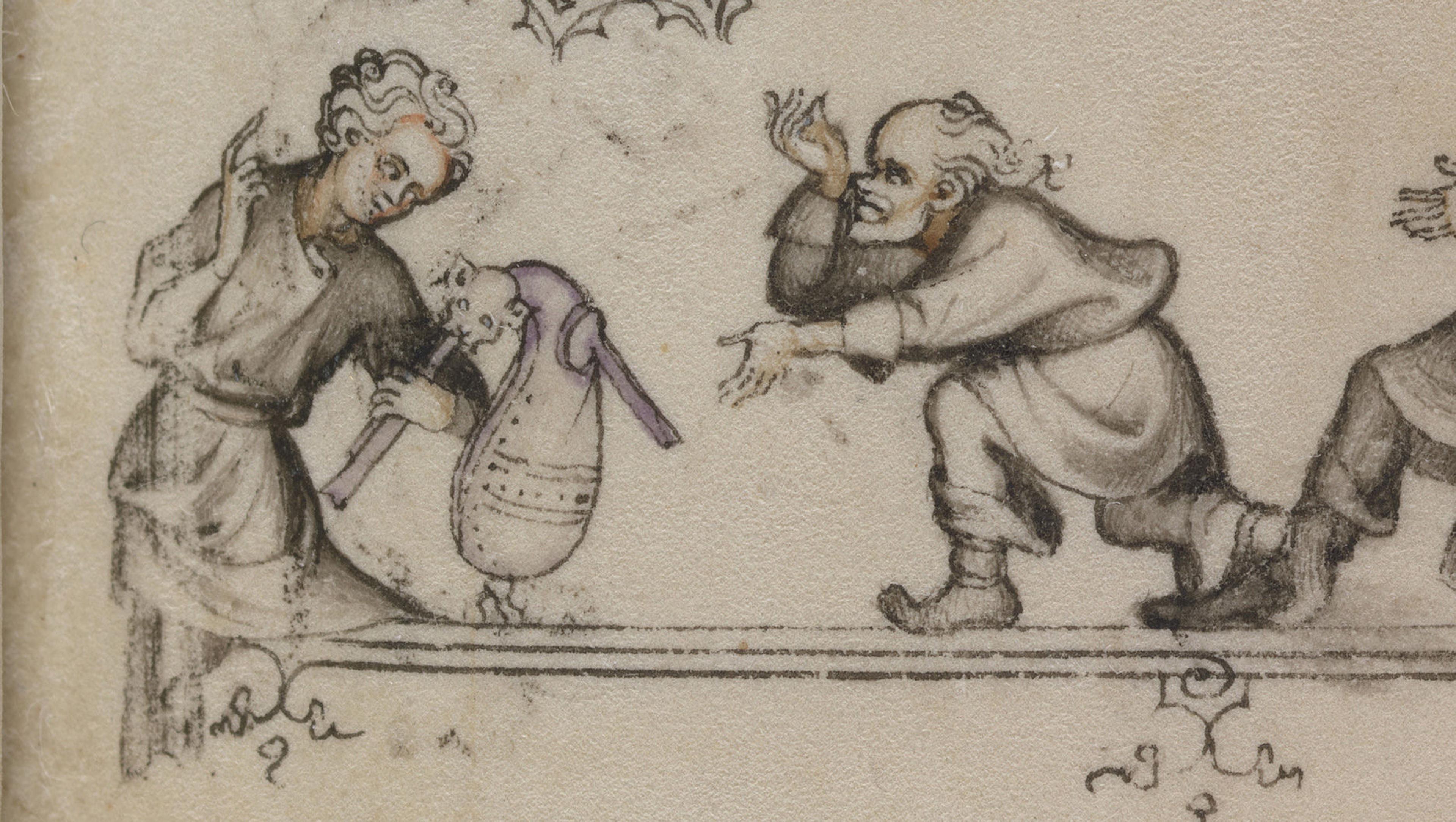
The bagpipe bag is covered with what looks like a detailed textile bag, and the melodic pope emerges from a gargoylesque head. Jean Pucelle (French, active Paris, 1319–34). Detail of Folio 35r of The Hours of Jeanne d'Evreux, Queen of France, ca. 1324–28. Grisaille, tempera, and ink on vellum, single folio: 3 5/8 x 2 7/16 in. (9.2 x 6.2 cm) Overall (with binding): 3 7/8 x 2 13/16 x 1 1/2 in. (9.9 x 7.2 x 3.8 cm). The Metropolitan Museum of Art, New York. The Cloisters Collection, 1954 (54.1.2)
The Met’s earliest bagpipe depictions can be found throughout The Hours of Jeanne d'Evreux, Queen of France (1324–28). Within this tiny illuminated manuscript, several different types of bagpipes can be found: some with drones, others without, some with animal heads sprouting the melodic pipes, others with simpler designs. The variety of bagpipes found in this one manuscript underscores the diversity of the instrument already in the early fourteenth century; their frequent illustration also marks them as well-known instruments that would have regularly been heard both in courtly environments and in the streets.
The main instrument that comes to mind when bagpipes are mentioned are, of course, the Great Highland bagpipes from Scotland. The Met owns a fine instrument made by Henderson in Glasgow around the 1930s, featuring a MacGregor tartan bag cover. Bagpipes appeared in Scotland around the fifteenth century. They were incorporated into Scottish clan culture, as clan pipers assumed positions traditionally occupied by bards.[1] Clan leaders had personal pipers who had often learned their skills in Ireland, where bardic—and later piping—schools were established. Although Scottish bagpipes are played extensively in civilian contexts, they are known across the world due to their presence in the British military. The use of bagpipes in European military contexts dates at least as far back as the sixteenth century, with examples recorded in Germany, Eastern Europe, and Ireland. In Scotland, bagpipes have been used in military contexts for centuries, but it is in the late eighteenth and early nineteenth centuries that the national imaginary was formed, branding the Highland pipes as a national and martial instrument.[2] In the 1980s, the Scottish smallpipes were developed, based on eighteenth-century examples found in Scottish museum collections. They use the same fingerings as the Great Highland bagpipes, but are much quieter, and encourage ensemble playing.

Peter Henderson (Scottish), Piob Mhór, before ca. 1940. Ebony, ivory, silver, leather, cloth, Length (Of chanter (including stock)): 17 3/8 in. (44.2 cm) Length (Of tenor drone): 18 1/2 in. (47 cm) Length (Of bass drone): 37 in. (94 cm) Length (Of tenor drone): 18 1/2 in. (47 cm) Length (Of bag): 23 in. (58.4 cm). The Metropolitan Museum of Art, New York. Purchase, Paul and Barbara Krieger Gift, 1996 (1996.223)
Bagpipes are most often associated with rural life. Shepherds played to while away the hours when tending their flock and had ready access to the materials necessary for making the instruments: animal hides, reeds, and wood. A small brooch made by G. L. Barberi in the nineteenth century represents what would have been a familiar scene to all Italians: two shepherds, one playing the zampogna (Italian bagpipe) and the other the piffero, a type of oboe. This traditional duet was played not only in Italy but also across nineteenth-century Europe as Southern Italians migrated to large cities such as Paris and London for work. Their presence was so ubiquitous that many nineteenth-century etchings and photographs of urban spaces feature Italian zampogna players, as in Charles Jacque’s etching of children playing these instruments in France. The zampogna is polyphonic, with two melodic pipes and two drones hanging from the same stock and held in front of the musician’s body; some were more than four feet long. The musician can play both the melody and an accompaniment with this setup, creating a wonderfully rich sound that listeners often compare to the organ.
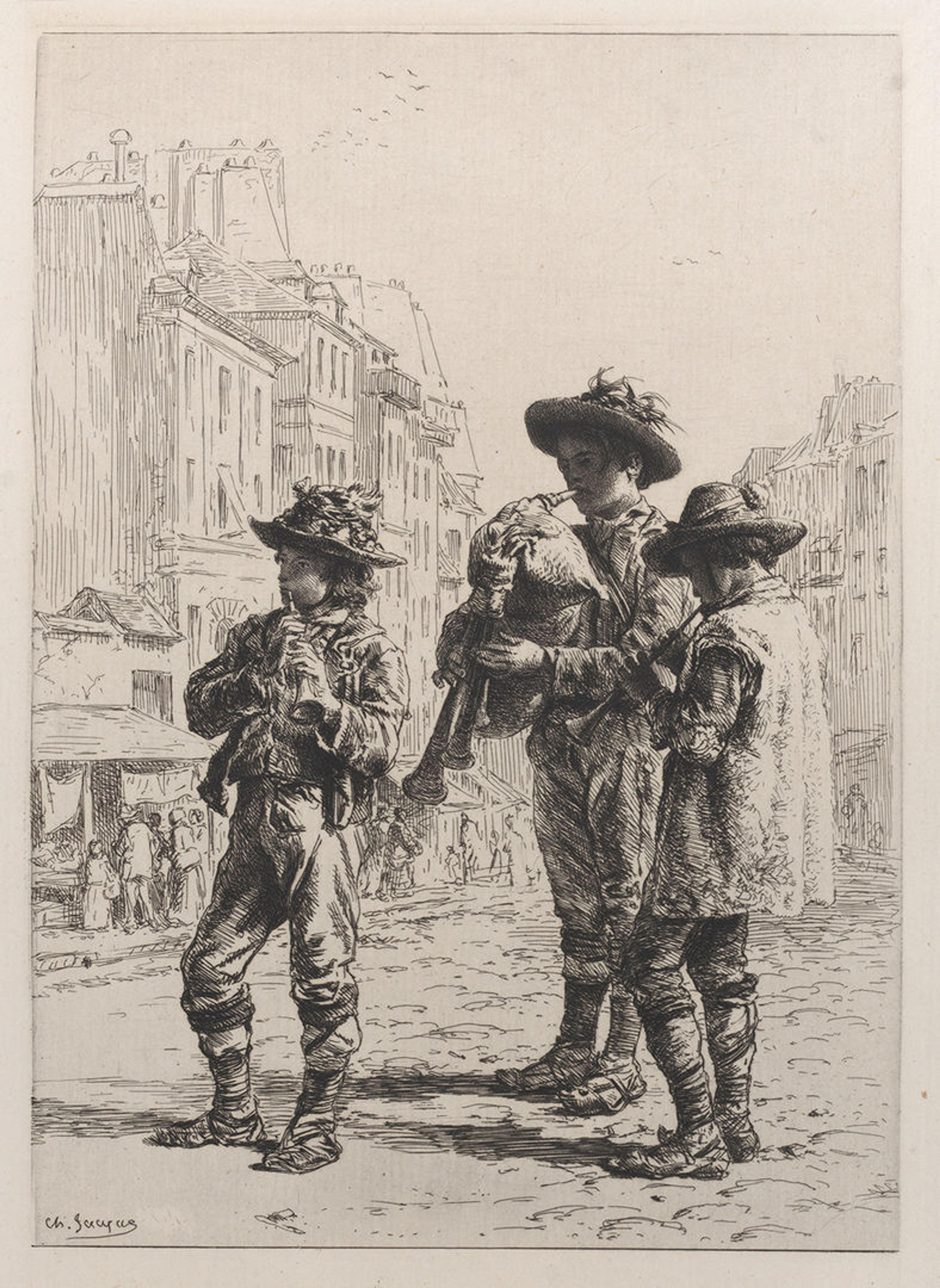
Charles Jacque (French, Paris 1813–1894). Pifferaris, 1864. Etching, Sheet: 18 13/16 × 13 3/8 in. (47.8 × 34 cm) Plate: 9 1/8 × 6 1/8 in. (23.3 × 15.5 cm). The Metropolitan Museum of Art, New York. Harris Brisbane Dick Fund, 1927 (27.10.42). This scene would have been common in the streets of Paris and London, where poor Southern Italian musicians often busked.
French aristocrats of the seventeenth and eighteenth centuries were avid consumers of idealized rural themes and favored the baroque musette, a form of bagpipe developed by instrument makers such as the Hotteterre family. The musette was visually embedded in tapestries, paintings, and architectural paneling. The Met showcases several examples in the Wrightsman Galleries: the Louis XV room paneling, for example, features two beautiful musettes reproduced in exquisite detail. Musettes were dainty instruments with a highly sophisticated mechanism. Their double melodic pipe allowed pipers to play counter melodies to the main tune, and the shuttle drones could change pitch easily, enabling pipers to play in many different keys. They were quiet indoor instruments, ideal for genteel chamber music. Baroque musettes were made of expensive materials such as ivory and ebony and dressed in fine textiles, including silk, brocade, and passementerie, sometimes matching the outfit of the lady or gentleman playing the instrument.
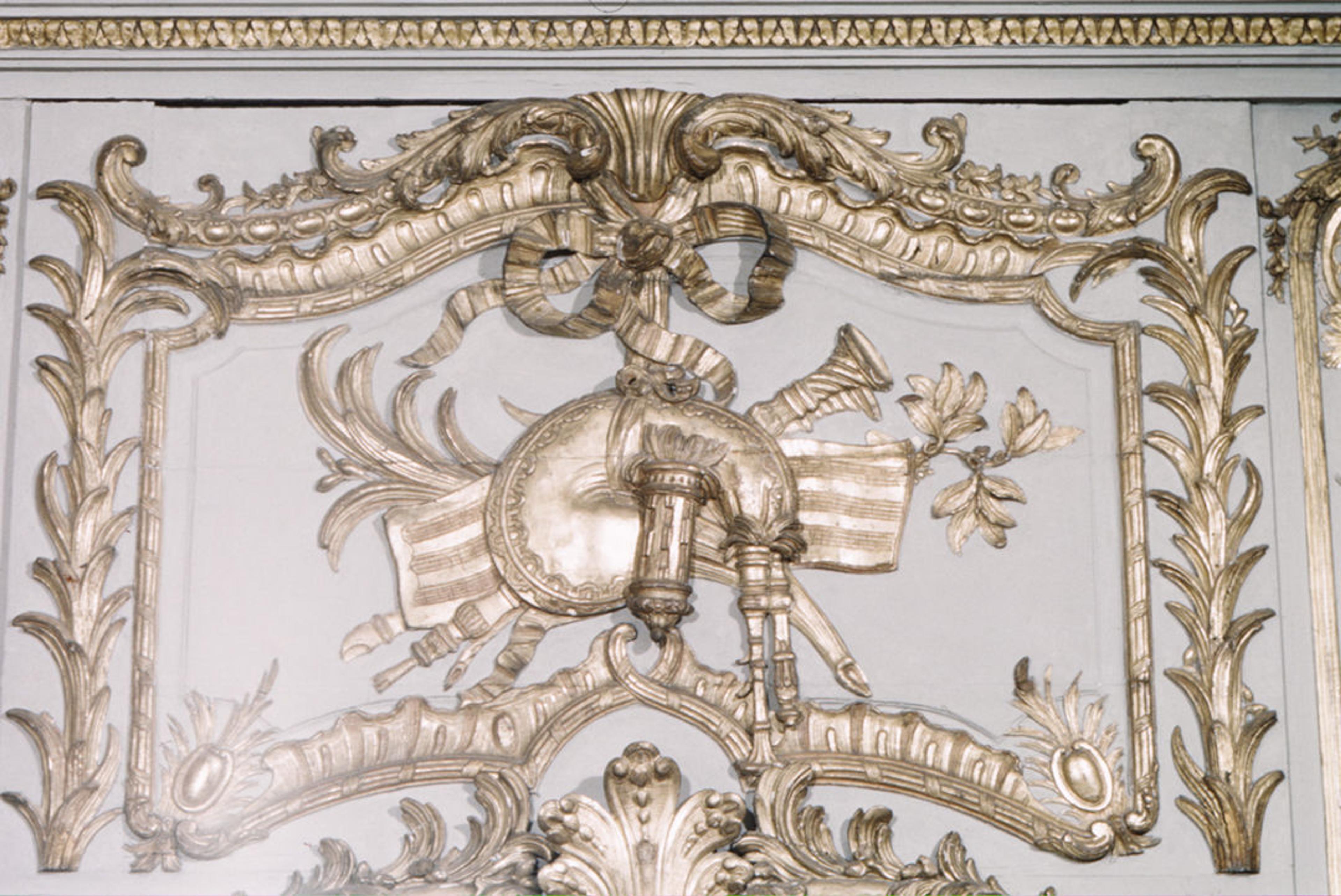
Attributed to, Jean-François Roumier (French). Paneling detail in The Louis XV Room, ca. 1720–25, with later additions. Carved, painted and gilded oak, Overall: H. 308 1/2 x W. 226 1/2 x D. 228in. (783.6 x 575.3 x 579.1cm); Crate (mirror): H. 95 1/4 x W. 112 1/2 x D. 8 in. (241.9 x 285.8 x 20.3 cm). The Metropolitan Museum of Art, New York. Gift of J. Pierpont Morgan, 1906 (07.225.147)
The most complex bagpipe ever invented is the sordellina, an Italian instrument created in the early seventeenth century, played by gentlemen amateur musicians. The Museum features a unique depiction of this instrument, placed in the hands of the cyclops Polyphemus who seeks to woo the nymph Galatea, as part of Todini’s golden harpsichord setting. Michele Todini, an eccentric seventeenth-century Italian collector, decided to create the Galleria Armonica e Matematica in Rome, a museum of mechanical objects and musical instruments. The golden harpsichord is one of the instruments he designed and the only remaining object of his museum. The sound of the bagpipe was activated by playing an additional keyboard below the harpsichord; the mechanism has since disappeared, but the presence of the sordellina in Polyphemus’s hands demonstrates how this instrument might have been perceived: sophisticated and important enough to be recreated in a mechanical museum, and placed in the hands of a giant, man-eating cyclops, covered in gilt that evokes Midas’s golden touch, freezing these characters from antiquity—and their anachronistic instruments—in time and space.
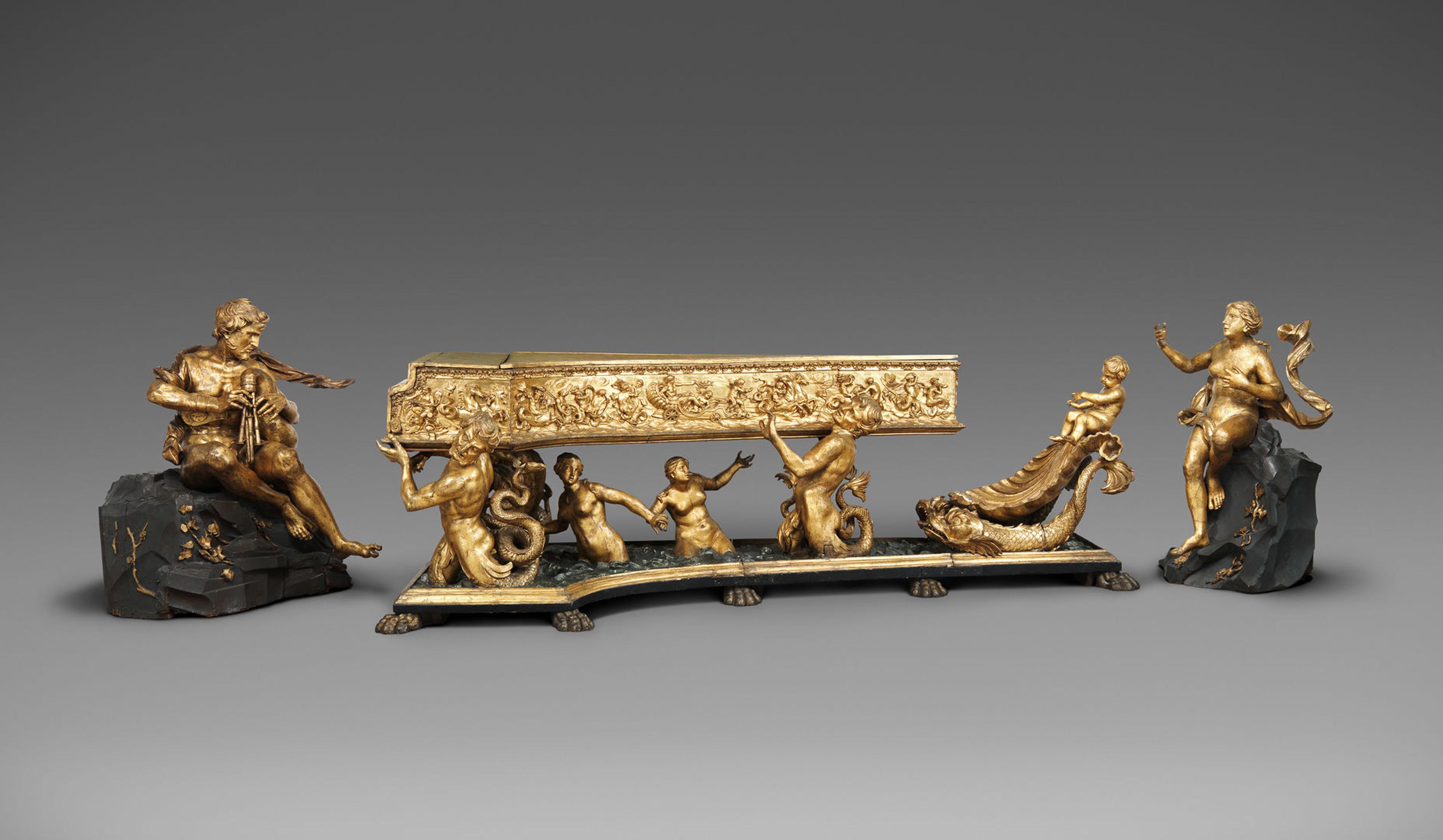
Designer: Michele Todini (Italian), designer: Basilio Onofri (Italian), gilt work: Jacob Reiff (Austrian). Harpsichord. Wood, gilt, ebony, ivory, parchment, Harpsichord: 14 3/4 in. × 9 ft. 10 in. × 38 in. (37.5 × 299.7 × 96.5 cm) Polyphemus: 50 × 60 × 52 in. (127 × 152.4 × 132.1 cm) Galatea: 35 × 57 × 47 in. (88.9 × 144.8 × 119.4 cm). The Metropolitan Museum of Art, New York. The Crosby Brown Collection of Musical Instruments, 1889 (89.4.2929a–e)
Some bagpipes retain close links to the rural world, which can manifest in explicit ways. One of the most striking examples is the bock, a type of bagpipe found across Bohemia. A print, a statuette, and a musical instrument all feature different versions of this instrument at The Met. The earliest of these is a harlequin (ca. 1736) playing a bagpipe, which sports a bag comprising a full goat: head, hooves, tail, and all. Earlier Eastern European bagpipes were known for featuring the entire animal. Michael Vereno, in The Voice of the Wind: A Linguistic History of Bagpipes (2020), suggests that the influence of French fashion in the mid-eighteenth century led the goat head to be replaced by wooden representations of a goat, often adorned with decorative elements. Two of these examples, an 1817 print by Johann Christoph Erhard and a nineteenth-century bagpipe from Nürnberg are in the collection, showcasing wooden carved goat heads, which serve as direct references to the animals sacrificed to make the instrument.
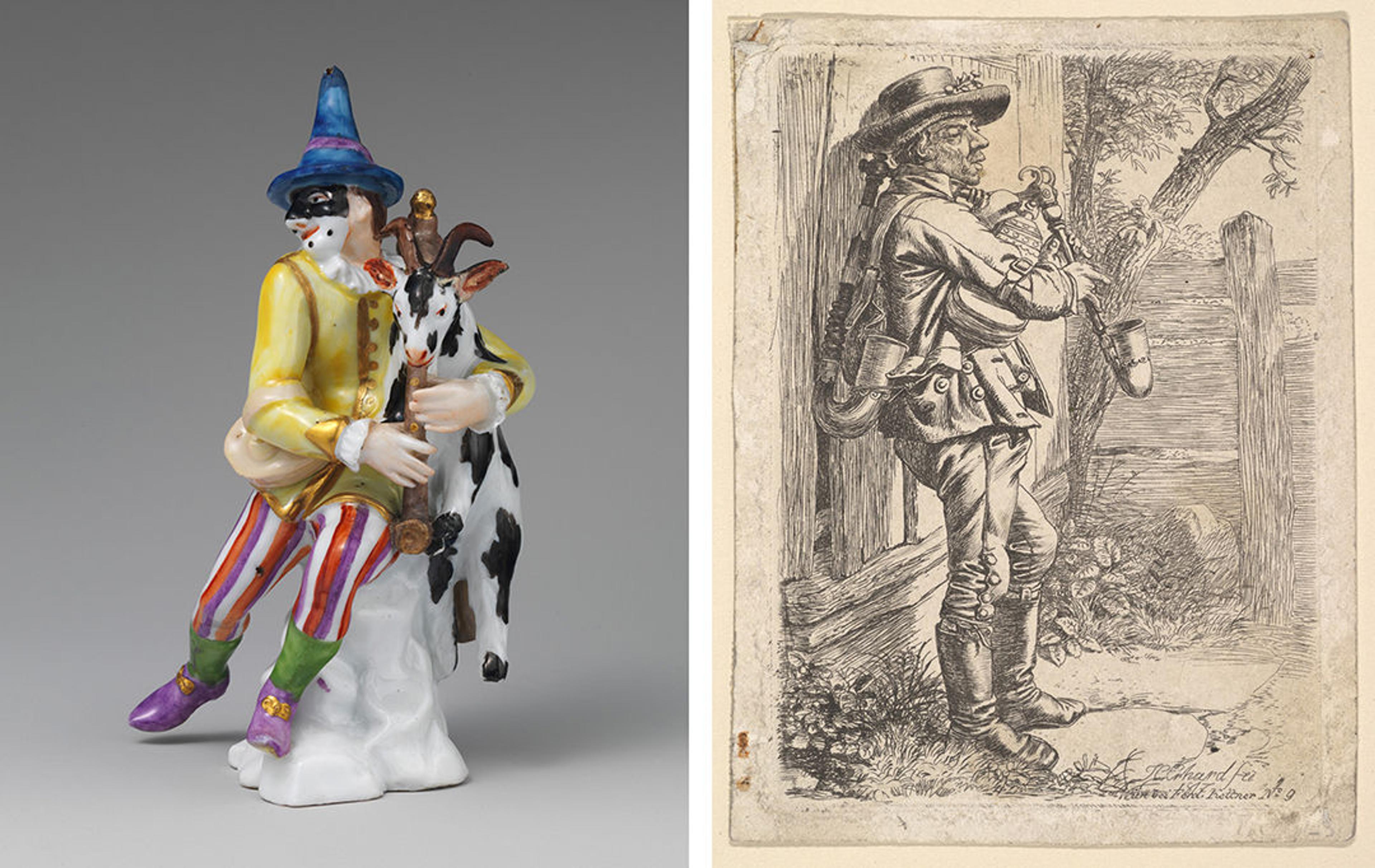
Left: Factory: Meissen Manufactory (German, 1710–present). Harlequin with Goat as Bagpipes, ca. 1736. Hard-paste porcelain, Overall (confirmed): 5 9/16 x 3 x 2 1/2 in. (14.1 x 7.6 x 6.4 cm). The Metropolitan Museum of Art, New York. The Jack and Belle Linsky Collection, 1982 (1982.60.316). Right: (Johann Christoph Erhard, German, 1795–1822) The Bagpiper, 1817. Etching; third state, plate: 3 7/8 x 2 15/16 in. sheet: 4 3/16 x 3/1/8 in. The Metropolitan Museum of Art, New York. The Elisha Whittelsey Collection, The Elisha Whittelsey Fund, 1949 (41.21.19)
Many more bagpipes hide within the Museum’s collection, and once your consciousness is alert, you’ll begin to spot them everywhere. On prints, in medieval manuscripts, hiding in altarpieces, behind angels playing all sorts of other instruments, amongst a crowd of Southern Indian dancers, in the corner of a tapestry, on upholstered chairs, in the Christmas tree nativity… Keep your eyes open. Little by little, these strange but wonderful instruments will appear, like musical easter eggs, peppering your day with delight and secret knowledge.
[1] Hugh Cheape, Bagpipes: A National Collection of a National Instrument (Edinburgh: NMS Enterprise Limited, 2008). Return
[2] Ibid. Return
